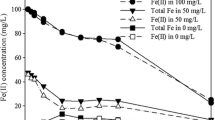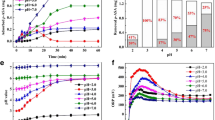Abstract
Selenite (SeO32−, Se (IV)) as well as selenate (SeO42−, Se (VI)) are the main forms of selenium existing in the aqueous media and acknowledged to upshot critical mutilation to well-being on surplus intake. Water is considered as one of the supreme itineraries for selenium inlet because of its adulteration with selenium via geogenic and anthropogenic practices. On the whole, Se (IV) is more noxious as compared to Se (VI); therefore, it is essential to develop remedial solution for their removal. The current work employs adsorption method and validates metal–organic framework based on iron, MIL-53 (MIL is fully known as Material of Institute Lavoisier), for selenium (IV) eradication from water. The Fe-MOFs are studied about influence of pH, preliminary selenite levels, time of contact, adsorbent dosage, etc., on the selenium removal efficacy. The selenium quantification is done with ion chromatography coupled with a conductivity detector. The study reveals that metal–organic framework based on iron could significantly remove selenite in aqueous conditions at an optimized pH 7 and a removal time of 4 h. Based on the higher correlation coefficient (R2) criterion, the selenite adsorption onto MIL-53 (Fe) is proposed to follow pseudo-second-order kinetics (R2 = 0.9655) and Langmuir adsorption (R2 = 0.9948) mechanism. Multiple regeneration and reuse experiments show that the MIL-53 (Fe) remained reusable with only 4% reduction in the adsorption efficiency after three cycles. The present finding thus presents a new media for selenite remediation from water.






Similar content being viewed by others
Abbreviations
- Fe-MOF:
-
Metal–organic framework based on iron
- MIL-53:
-
Material of Institute Lavoisier
- USEPA:
-
United States Environmental Protection Agency
- WHO:
-
World Health Organization
- MCL:
-
Maximum Contamination Limit
- FeCl3·6H2O:
-
Ferric chloride hexahydrate
- 1,4-BDC:
-
1,4-benzene carboxylic acid
- DMF:
-
Dimethylformamide
- HF:
-
Hydrogen fluoride
- DDI:
-
Double deionized
- TA:
-
Teflon-lined autoclave
References
Ahmadi M, Janakiram S, Dai Z, Ansaloni L, Deng L (2018) Performance of mixed matrix membranes containing porous two-dimensional (2D) and three-dimensional (3D) fillers for CO2 separation: a review. Membranes 8:50
Atalay A (1990) Selenium speciation in ground water. Quarterly report. Oklahoma Univ., Norman, OK (United States). School of Civil Engineering and Environmental Science
Awual MR, Yaita T, Suzuki S, Shiwaku H (2015) Ultimate selenium (IV) monitoring and removal from water using a new class of organic ligand based composite adsorbent. J Hazard Mater 291:111–119
Bailey RT (2017) Selenium contamination, fate, and reactive transport in groundwater in relation to human health. Hydrogeol J 25:1191–1217
Borah P, Sharma V, Malakar A, Bhinder SS, Kansal SK, Devi P (2022) A facile method for detection and speciation of inorganic selenium with ion chromatography. Chromatographia 85:213–218
Chan Y-T, Kuan W-H, Tzou Y-M, Chen T-Y, Liu Y-T, Wang M-K, Teah H-Y (2016) Molecular structures of Al/Si and Fe/Si coprecipitates and the implication for selenite removal. Sci Rep 6:1–12
Chaturvedi G, Kaur A, Kansal SK (2019) CdS-decorated MIL-53 (Fe) microrods with enhanced visible light photocatalytic performance for the degradation of ketorolac tromethamine and mechanism insight. J Phys Chem C 123:16857–16867
Chen X (2015) Modeling of experimental adsorption isotherm data. Information 6:14–22
Cornelis R (2005) Handbook of elemental speciation II: species in the environment, food, medicine and occupational health. John Wiley & Sons, New York
Drout RJ, Howarth AJ, Otake K-I, Islamoglu T, Farha OK (2018) Efficient extraction of inorganic selenium from water by a Zr metal–organic framework: investigation of volumetric uptake capacity and binding motifs. CrystEngComm 20:6140–6145
Fındık S, Gülfen M, Aydın AO (2014) Adsorption of selenite ions onto poly (1, 8-diaminonaphthalene) synthesized by using ammonium persulfate. Sep Sci Technol 49:2890–2896
He Y, Tang YP, Ma D, Chung T-S (2017) UiO-66 incorporated thin-film nanocomposite membranes for efficient selenium and arsenic removal. J Membr Sci 541:262–270
Ho Y-S, McKay G (1998) Sorption of dye from aqueous solution by peat. Chem Eng J 70:115–124
Howarth AJ, Katz MJ, Wang TC, Platero-Prats AE, Chapman KW, Hupp JT, Farha OK (2015) High efficiency adsorption and removal of selenate and selenite from water using metal–organic frameworks. J Am Chem Soc 137:7488–7494
Kalantari H, Manoochehri M (2018) A nanocomposite consisting of MIL-101 (Cr) and functionalized magnetite nanoparticles for extraction and determination of selenium (IV) and selenium (VI). Microchim Acta 185:1–8
Kang M, Chen F, Wu S, Yang Y, Bruggeman C, Charlet L (2011) Effect of pH on aqueous Se (IV) reduction by pyrite. Environ Sci Technol 45:2704–2710
Lag J (1990) Geomedicine. CRC Press, Boca Raton
Lagergren S (1898) Zur theorie der sogenannten adsorption geloster stoffe
Li J, Liu Y, Wang X, Zhao G, Ai Y, Han B, Wen T, Hayat T, Alsaedi A, Wang X (2017) Experimental and theoretical study on selenate uptake to zirconium metal–organic frameworks: effect of defects and ligands. Chem Eng J 330:1012–1021
Ling L, Pan B, Zhang W-X (2015) Removal of selenium from water with nanoscale zero-valent iron: mechanisms of intraparticle reduction of Se (IV). Water Res 71:274–281
Ma Z, Shan C, Liang J, Tong M (2018) Efficient adsorption of Selenium (IV) from water by hematite modified magnetic nanoparticles. Chemosphere 193:134–141
Macfarquhar JK, Broussard DL, Melstrom P, Hutchinson R, Wolkin A, Martin C, Burk RF, Dunn JR, Green AL, Hammond R (2010) Acute selenium toxicity associated with a dietary supplement. Arch Intern Med 170:256–261
McNeal JM, Balistrieri LS (1989) Geochemistry and occurrence of selenium: an overview. Selenium Agric Environ 23:1–13
Nguyen DTC, Le HTN, Do TS, Pham VT, Dai Tran L, Ho VTT, Tran TV, Nguyen DC, Nguyen TD, Bach LG (2019) Metal-organic framework MIL-53 (Fe) as an adsorbent for ibuprofen drug removal from aqueous solutions: response surface modeling and optimization. J Chem. https://doi.org/10.1155/2019/5602957
Ouyang H, Chen N, Chang G, Zhao X, Sun Y, Chen S, Zhang H, Yang D (2018) Selective capture of toxic selenite anions by bismuth-based metal–organic frameworks. Angew Chem Int Ed 57:13197–13201
Roane TM, Pepper IL, Gentry TJ (2015) Microorganisms and metal pollutants. In: Environmental microbiology. Elsevier, Amsterdam
Singh VP (2005) Toxic metals and environmental issues. Sarup & Sons, Delhi
Sullivan P, Agardy FJ, Clark JJ (2005) The environmental science of drinking water. Elsevier
Sun W, Pan W, Wang F, Xu N (2015) Removal of Se (IV) and Se (VI) by MFe2O4 nanoparticles from aqueous solution. Chem Eng J 273:353–362
Takada H, Watanabe Y, Iwamoto M (2004) Zirconium sulfate–surfactant micelle mesostructure as an effective remover of selenite ion. Chem Lett 33:62–63
van Tran T, Nguyen DTC, Le HT, Tu TT, Le ND, Lim KT, Bach LG, Nguyen TD (2019) MIL-53 (Fe)-directed synthesis of hierarchically mesoporous carbon and its utilization for ciprofloxacin antibiotic remediation. J Environ Chem Eng 7:102881
Virk HS (2019) Selenium contamination of groundwater of Malwa Belt of Punjab, India. Res Rev J Toxicol 9:13–20
Vu TA, Le GH, Dao CD, Dang LQ, Nguyen KT, Nguyen QK, Dang PT, Tran HT, Duong QT, Nguyen TV (2015) Arsenic removal from aqueous solutions by adsorption using novel MIL-53 (Fe) as a highly efficient adsorbent. RSC Adv 5:5261–5268
Wang R, Xu H, Zhang K, Wei S, Deyong W (2019) High-quality Al@ Fe-MOF prepared using Fe-MOF as a micro-reactor to improve adsorption performance for selenite. J Hazard Mater 364:272–280
Wei J, Zhang W, Pan W, Li C, Sun W (2018) Experimental and theoretical investigations on Se (IV) and Se (VI) adsorption to UiO-66-based metal–organic frameworks. Environ Sci Nano 5:1441–1453
Zhang Y, Li G, Lu H, Lv Q, Sun Z (2014) Synthesis, characterization and photocatalytic properties of MIL-53 (Fe)–graphene hybrid materials. RSC Adv 4:7594–7600
Acknowledgements
Authors acknowledge the constant support received from the Prof. S. Anantha Ramakrishna, Director, CSIR-CSIO. Funding support under MLP0058 is also acknowledged.
Funding
Funding support under MLP0058.
Author information
Authors and Affiliations
Contributions
All authors contributed to the study conception and design. Material preparation, data collection, and analysis were performed by [VS], [PB]. The first draft of the manuscript was written by [VS], and all authors commented on the previous versions of the manuscript. All authors read and approved the final manuscript.
Corresponding author
Ethics declarations
Conflict of interest
The authors have no relevant financial or non-financial interests to disclose.
Additional information
Editorial responsibility: Samareh Mirkia.
Rights and permissions
Springer Nature or its licensor (e.g. a society or other partner) holds exclusive rights to this article under a publishing agreement with the author(s) or other rightsholder(s); author self-archiving of the accepted manuscript version of this article is solely governed by the terms of such publishing agreement and applicable law.
About this article
Cite this article
Sharma, V., Borah, P., Bhinder, S.S. et al. Study of iron-based metal–organic framework for selenite removal from water. Int. J. Environ. Sci. Technol. 21, 4147–4156 (2024). https://doi.org/10.1007/s13762-023-05269-x
Received:
Revised:
Accepted:
Published:
Issue Date:
DOI: https://doi.org/10.1007/s13762-023-05269-x




